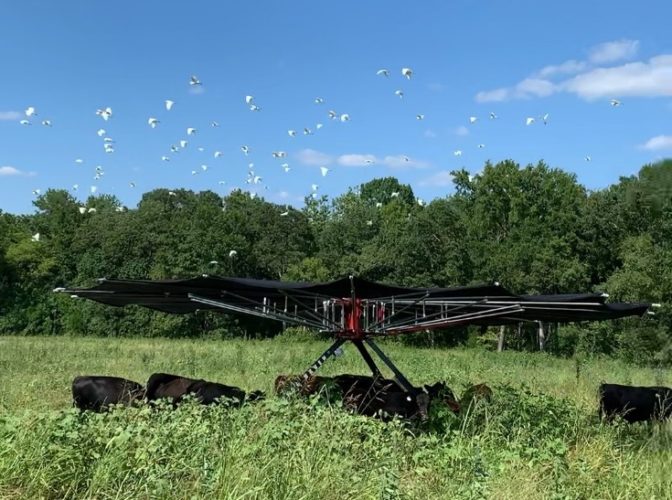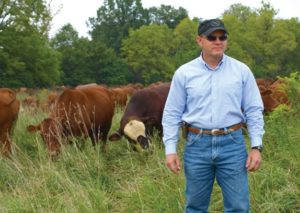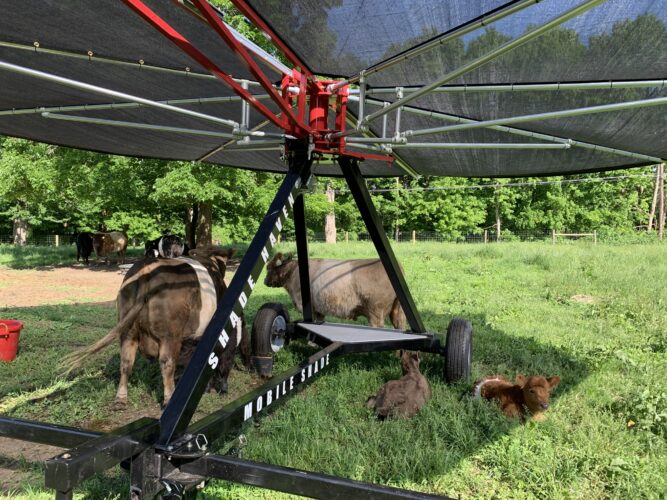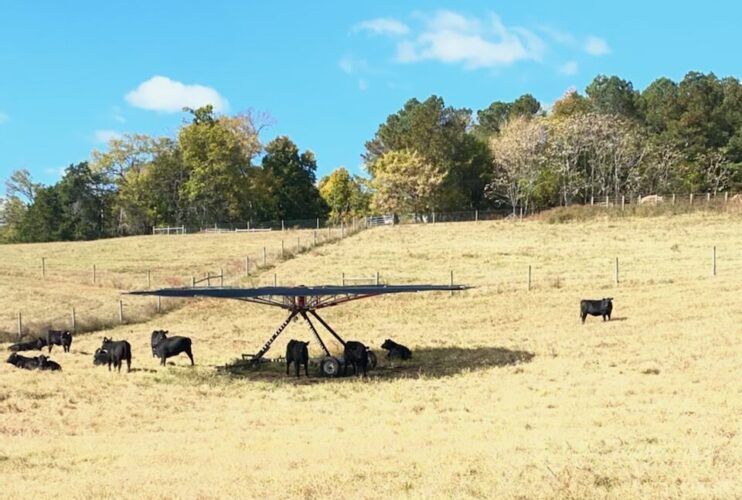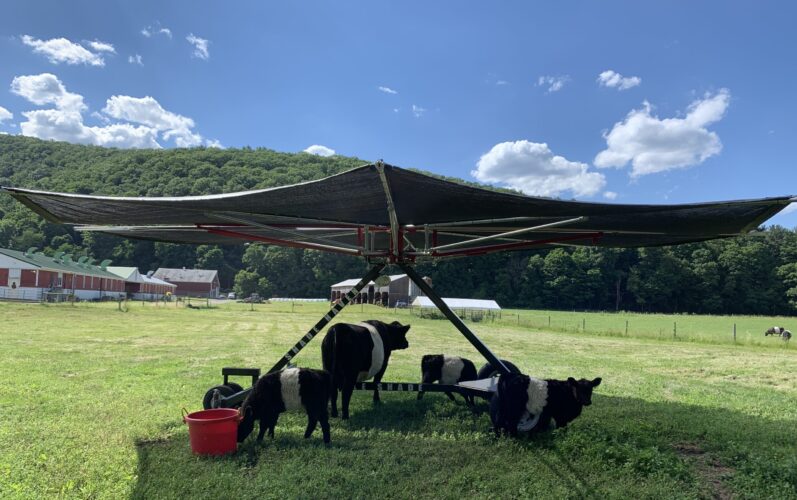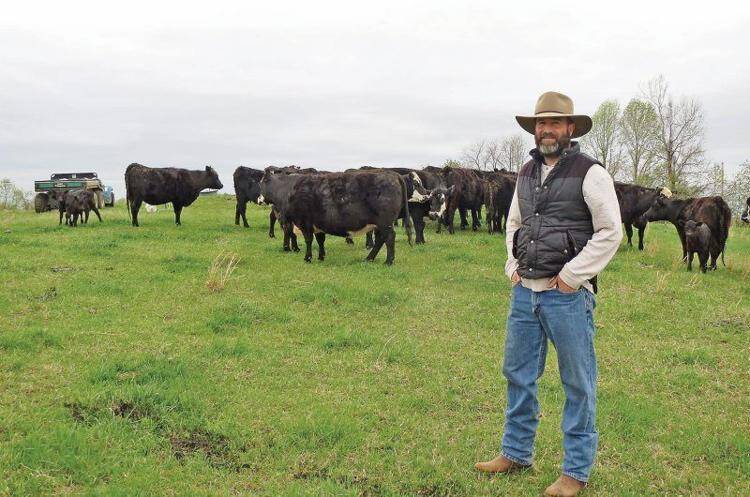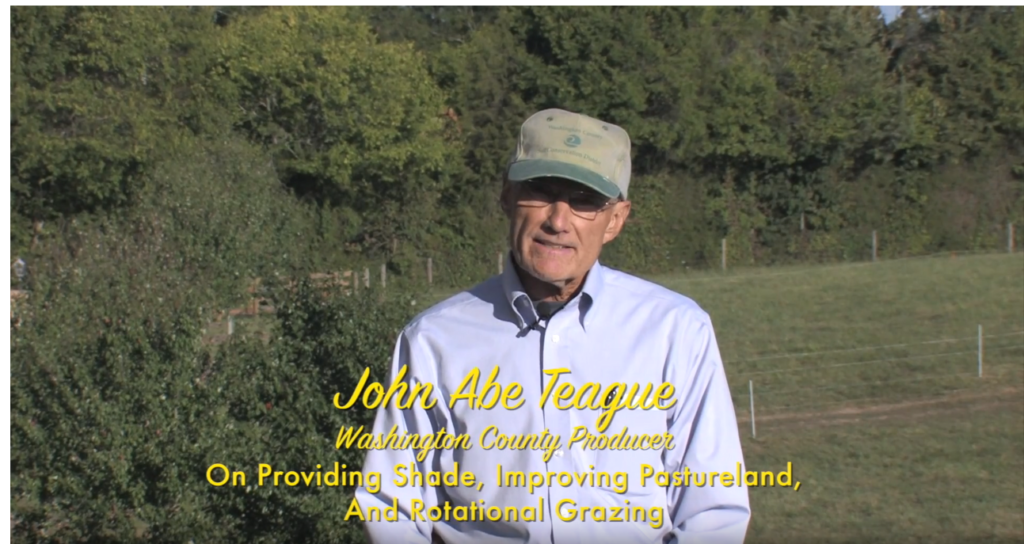HOW AND WHY SMART FARMERS ALL ACROSS AMERICA ARE CREATING MOBILE SHADE FOR THEIR LIVESTOCK
by WILL WINTER, DVM (As appeared in Stockman Grass Farmer, 2020)
There’s a somewhat popular phrase that has been going around in our livestock producers circles for quite a few years and I feel compelled to state right up from that the saying kind of irks me. The saying is “We don’t pamper our cows”. Pamper? Wait a minute? Isn’t that supposed to be a good thing? (Poet ROBERT BLY has stated that “wait a minute” are the three most powerful words in the English language.).
Well, looking at it another way, I do understand part of the logic behind the phrase, there is an extreme which is usually good to avoid, but still that doesn’t justify the use of the “no pampering” concept to deprive any farm animals of their basic needs and comfort. More about animal comfort later.
WHAT IS PAMPERING?
But back to pampering, I believe that not only is it the right thing to do, it is actually very closely connected to the creation of a financially profitable herd. That’s the main difference between providing for essential needs, the basics of life, as compared to artificial living through drugs. Sure, an animal or even a human, can exist without comfort throughout their life, but why? Why live that way when a blessed life is equally possible? Why even consider it when, even at the most basic level, animals living in comfort will make us more money? What I’m going to show you is that animals that have all the comforts are not really “pampered poodles”, but they will do better, and in turn, they will help you do better.
As a funny side note to this, I grew up in a Kansas farm family and I have some love/hate memories of plowing wheat fields in July and August following harvest. In addition to baking my brains out, I was able to accrue enough skin damage from the sun to last me a lifetime at the dermatologist. Shortly after I moved to Minnesota, I clearly remember seeing my first tractor with an old-fashioned beach umbrella mounted over the tractor seat! Brilliant!! I was stunned that no Kansan I ever saw had figured it out. Now, of course, it looks odd to see someone on a tractor without a cab to protect the farmer from the elements. My how we evolve!
This whole issue of properly and profitably raising cattle in hot summer weather really came to light for me when I visited the Wisconsin farm of VINCE HUNDT. Vince is the person who lead the team that developed and created the Shade Haven Portable Shade Mobiles and he really helped me understand the solution to an oft-ignored problem. Vince saw a need and was able to rely on his manufacturing and farming background to create a tool for solving the ubiquitous problem that may occur at certain times of the year wherein animals are too hot to graze. All shade has value, but we have all seen the pasture damage created when the only shade comes when the livestock can bunch up under trees. The concentrated manure can also become a fly breeding ground making those matters worse. (heavy fly pressure also makes cattle want to congregate tightly in the shade where they are obviously not grazing, not making profit. This is yet another reason to do everything within your power to lower the fly population! See our previous messages about the Top Ten Ways to get rid of flies).
JOEL SALATIN, editor of the Stockman Grassfarmer magazine, long-time grazer and creator of his own home-made shade mobiles stated in the magazine that he “looks forward to the day when shade mobiles will dot every livestock farm in the nation”. I think he’s exactly right. Joel was even clever enough to assemble his own shade mobiles utilizing nothing more expensive than used farm junk, for a materials cost of near zero. Not pretty, but the cattle have never once complained!
O.K. I’M SOLD ON THE CONCEPT, WHERE DO I GET ONE?
Obviously the easiest would be to buy a pre-made and well-designed commercial unit. A Shade Haven for example. (see shadehavens.com for full pricing and more details). They are a work of art, and perhaps the ultimate in function. These 30-40’ circles fold up into a narrow strip like an Asian fan so they can roll down the highway or be trailed behind an ATV. They are easy to quickly deploy. It’s almost impossible to fault them in any way. They are built to withstand wind gusts up to 50 mph, and many other weather extremes. Accessories include mineral hoppers, oilers for insect repellent, even back scratchers.
RON and JUDI LOCKE, ranchers in SW Missouri are a classic example of happy Shade Haven customers. After early retirement they have been raising cattle for the past 20 years. It has dawned on them improving their soil microbial health is their number one ranch goal. However, 15 of the Locke’s 27 paddocks have no shade. Two of those the without shade are warm season grasses, most productive from July through early September when temperaturess in Missouri soar above 90 degrees.
“So here I have these wonderful warm season paddocks and no shade,” says Ron Locke.” I couldn’t put my fall cows in those fields, because it was too hot and they didn’t have shade. Now I can put my cattle anywhere I want. It has completely changed my ability to graze my fields the way I want to graze them.
The Locke’s raise black Angus, which, frankly, are cattle that were designed to live and perform in the lovely , cloudy and cool highlands of Scotland. Sure, the Locke’s could have switched to red cattle or the heat-tolerant-designed and highly recommended Misouri-bred Southpoll breed, but it would still not have the desired effect they hope to achieve with overall pasture utilization and protection of the soil microbia.
There are hundreds of similar success stories from other Shade Haven customers. There are few if any unhappy customers and the number one reaction after their first experience is to come back for several more units.
The most beautiful and perhaps most efficient home-built were designed and created by TED STEVENS for his Texas cattle. Born of sculptured aluminum pipe, his devices roll easily on used aircraft wheels and tires, these machines look as if they could fly. They don’t, but his include mineral hoppers, oilers and even a portable water tank along with mister spray nozzles all around to make grazing near them a happy place.
Minnesotan rancher DUANE MUNSTERTIGER and son TONY have also constructed rugged and muscularly handsome shade units using nothing more exotic than iron pipe and I-beams. (see pictures of both below). They also include mineral hoppers and oilers for flies, one even has a back scratcher.
THE FOUR MAIN REASONS TO MAKE PORTABLE SHADE AVAILABLE-
- BETTER ANIMAL FERTILITY, HEALTHY AND WEIGHT GAINS– And now we are talking about how to make a shade mobile pay for itself. And, yes, it’s true, they will. After one gets over the original sticker shock of the price, the best part is yet to come. Actually, the main reason we would want to provide portable shade is quite often completely overlooked. We now see the purchase not as an expense or a cost but as an investment. Take it directly from DR ALAN WILLIAMS, who lives and does ranching research in hot and humid Mississippi. He has documented that cattle, no matter where they live, will consume 50 to 70% less dry matter when they are suffering from heat stress. So, not only are they not gaining, they are actually losing condition. Putting condition back on that has been lost is a massively expensive proposition. Vince Hundt speculates that just this savings alone will pay for a commercial shade mobile in just a few years.
Studies show that cattle start feeling heat stress at any temperature above 72 degrees F. In fact, the copious heat that arises from the 50 gallon fermentation tank called the rumen means that cattle handle cold weather better than hot weather, actually finding peak function and comfort at around 42 degrees F. Scientific studies show that cattle with access to shade gained 0.47#/day more than identical cattle and pasture but without shade. This adds up!
2) BETTER PASTURE UTILIZATION– It’s quite common to see pastures that are underutilized solely because the cattle don’t have what they need, which often includes lack of shade. Getting into these pastures is essential for maximum utilization of the entire paddock, farm or ranch. Dr. Williams also points out another aspect of shade in general. In this case the overall shade protection that keeps soil temperature cooler. Full-pasture shade can be created by allowing grasses to reach the mid-stage of maturity. This will create soil that is more moist, more cool. Dr. Williams’ study shows as much as a 50-degree improvement, often seeing soil temperatures variance from 80 to 140F when comparing a well-managed pasture vs. one that is poorly managed. This means that cattle standing on poor pastures with overheated soil is about the equivalent of us standing on a hot blacktop road in August in Texas. When that soil temperature reaches 140 degrees F, and it will, we have just destroyed soil livestock populations. When we successfully graze with proper rotation and rest periods, we are sequestering carbon, building more carbon. With each 1% increase in organic matter in the soil, we can store an additional 20,000 gallons of water per acre. Additinally, when you see patches of thistles or other invasive weeds in a pasture, you know exactly where to park your shade mobile!
3) HELPING TO REVERSE THE EFFECTS OF CLIMATE CHANGE– No matter what one’s beliefs about climate change are, no one can argue with the facts, figures and observations that we are getting hotter, we have more extremes, more droughts, more flooding and more storms than before. There are few, if any, technologies that do more to protect our climate than sustainable, regenerative livestock grazing. We strive daily to achieve the elimination of all bare soil, preventing overgrazed/dead areas and the creation of a full mat of plants. This creates a year-round protection umbrella over the land that we love. The primary tools that we use include portable water systems, portable fencing, adequate free-choice mineralization of the livestock, and now we can measure the value of creating portable shade.
4) WHY SETTLE FOR LESS THAN “FEEL GOOD” FARMING? After all these thoughts about the comfort of the animals, animal performance, soil and plant health, and even the saving of the planet itself, what about us? Even the most remote ranch or farm is also not out of reach of city people or other concerned citizens that are worried about whether or not farmers care for their animals. People that could report your herd to humane organizations. The fact is, fear of cruelty to animals drives swarms of people to vegetarianism or, worse, the dangerous cult of veganism. When passersby see a shade mobile with happy-looking cattle under it, it’s a real traffic stopper. They smile, they take photos, they tell their friends. One highly significant ray of light we can give to the people that eat our livestock is to show them in every way possible that we DO care and we do provide comfort, and, well, yes, pampering to our animals! Almost everyone resonates with happiness whether it’s thriving green plants and flowers, calm, grounded and centered farm animals, and, luckily for us, they want to see farmers that are healthy, concerned for all life and happiness!
THE HUNDREDTH MONKEY THEORY
All in all, I think we are approaching a cusp in thinking, call it a paradigm shift if you will. I think it’s clear to se that before long, every single successful livestock producer will have that same “Aha’ moment! We started with portable fencing, we got portable water, portable mineral hoppers, and now, portable shade mobiles! I think the time is at hand when we all realize that we can never again afford to put our livestock into a shadeless paddock on a hot summer day. If that shade is portable and easy to move, the benefits multiply even more! I look forward to that day! I know that all of our livestock feel the same way!
WILL WINTER is a retired veterinarian, a holistic herd health consultant and livestock nutritionist who hangs his hat in Minnesota. He is also a traveling lecturer and teacher focusing on sustainable livestock production and traditional nutrition. He provides consultations, workshops, lectures and access to natural livestock supplies to farmers and ranchers.
practicallivestocksolutions.com
willwinterdvm@gmail.com

